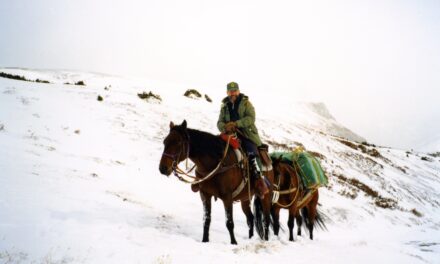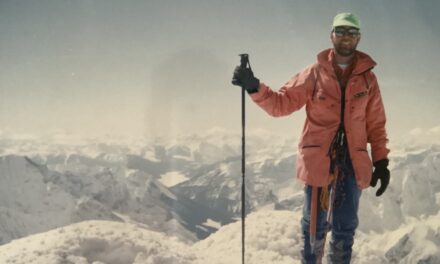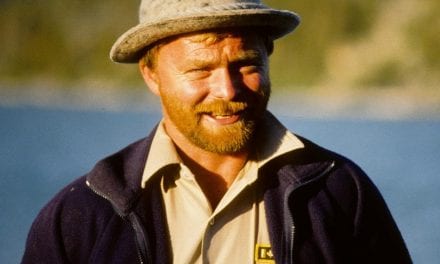Park Warden Oral History Project 2014
Self-generated oral history – Edwin Knox
Place and date of birth? Charlottetown, Prince Edward Island in 1959.
Where did you grow up?
I spent my first 18 years on Prince Edward Island. I had heard about the magic of the Rocky Mountains from when I was nine or ten …my eldest sister grew to know and love the mountains working at the Chateau Lake Louise for a couple of summers. Staff could get a free train trip from Atlantic Canada to the Rockies. My sister’s postcards, letters, phone calls, and visits home sparked her younger brother’s imagination. I was 14 when I first breathed the mountain air and hiked the mountain trails! 1973 – a camping trip – driving across Canada in the new International Scout …our eldest brother at the wheel …another sister, her friend, and me. From the Atlantic to the Pacific and back again in forty days! We spent a week camping and hiking in the Lake Louise area. Indeed, I fell in love with the mountains! I knew I’d return when I completed high school. In 1977 I was “Alberta Bound” …as the song goes! I motorcycled to Field, B.C. where my eldest sister was then living, and got a job in Lake Louise. And what a change from PEI National Park …the mountain parks!

Edwin Knox – January 2016
But national parks were nothing new to me. With my parents we visited the north shore beaches of PEI National Park frequently through the summer months. My grandfather, George Watts – mother’s father – worked in the park when he wasn’t busy on his nearby farm, road building in the 1930s. The old family photo albums have pictures from the early 1900s of our family camped at Stanhope. The national park was created there in 1937. In the early ‘70s with my mother, we frequently attended guided nature walks in the park and other natural areas of PEI. And we’d visit the beaches too on the wildest of winter days. We’d snowshoe and cross-country ski on the Park’s forest and farmlands trails. I really do thank my parents for instilling in me and my siblings, an appreciation and understanding of the value of nature, and of the national parks. My parents had strong rural backgrounds. We had a huge vegetable garden and ate fish my mom’s cousins and my father caught. Dad would fill the freezer with cod and mackerel for the winter. And he harvested trout for home consumption from streams he fished his whole life. On our large lot in Sherwood, we had meat animals and pets galore – pigs, chickens, ducks, rabbits, goats, dogs, cats, racoons (even a weasel for a short time). Dad could pluck a duck or a goose, or skin a rabbit or an eel, like nobody’s business. He grew up on a beautiful property on the Island …his father Bill Knox managed the Montague Electric Company hydro dam – and raised his family in the impressive house above the dam – now listed in the Canadian Register of Historic Places as Knox’s Dam …a popular PEI tourist destination. A visit to Grampie and Grammy’s place was a visit to our own “park” of sorts, as I recollect, in my childhood memories. Yes, both of my parents loved time in nature – and really did instill that love, in all their nine children.
Yes, a park warden career for me in the mountain national parks – quite something for a Spud Islander! And on a side note, I was not the first park warden from Charlottetown – there was Bo Holroyd – long time Waterton warden, 1920-1947 …he and his wife Constance and family, as documented so well in “Silent Partners” by Anne Dixon.
How did you become involved in the warden service? Which national park did you start working in?
I worked first in the private sector in the parks – the Post Hotel as a dishwasher/cook – off and on from 1977-1979. I’ve stories about the grizzly bear Spassky! I worked on The Big Hill for CPRail doing track maintenance, memorably chipping ice in the tunnels – again, off and on for a few employment periods between 1977 and 1985 including out of the Field train station (crew clerk, cook on the auxiliary unit for derailment emergencies, and operator); then four years as chore boy at Skoki Ski Lodge. Summers too, in those years (1981-1984) with Paul Peyto and his Timberline Tours – packing, cooking and guiding in the Pipestone and Red Deer Lakes country. I took a horse packing course, instructed by warden Don Mickle and Brewster Mountain Pack Train’s Brett Mitzel. I got to know the wardens too at Skoki …visits with Dale Loewen, Frank Burstrom, Bill Browne, Diane Volkers, and others …at Skoki and nearby Red Deer Lakes Patrol Cabin. I’d met “Timberline Jim” Deegan by then. I’d discovered his “Timberline Tales – folklore in verse of the Canadian Rockies” book of poetry at Skoki and oh boy did I like his stories in rhyme! That was quite an education really as regards the Warden Service. I’d visit him and his wife Doreen in Banff. I cherish the memories of those visits. In Field I got to know all the warden crew when I hired on with a contract trail crew at Lake O’Hara in 1984 and with the Park’s crew in ‘85. I really got my foot in the door when around the same time I had a contract with Parks to track the herd of radio-collared elk in Yoho. As well, in the late 1980s, I had the opportunity to assist tracking collared grizzly bears in the Yoho-Kootenay bear study. I was well known …trusted for my ableness on the trail – alone in the backcountry on foot, horseback, or ski …to cover the miles – get the work done.
What made you want to join the warden service?
What with all that growing appreciation for the “Outfit” as they say, I understood I’d best get some education if I wanted to hire on. I only had Grade 12. My older brother Billy encouraged me to go to Lethbridge College and get my diploma in Environmental Science. Others too vouched for the program. I visited the college. Met with some of the instructors and I got at it! Five semesters later I graduated with honours. I really did enjoy the very applicable studies and met many fine people who became life-long friends. I hired on as a park warden in the early summer of 1989 – one of the last to hire on with just a two-year diploma. While going to school, I worked summers in Yoho …trail crew and visitor services. Those were busy years and I had great energy for all that was required …study, work, and time for some good play! I love reading my journals from those years …I was a busy boy!
What different parks did you work in? How did they compare? Do you have a favourite?
From Yoho I went to Waterton Lakes in 1991. Waterton was a nice change from Yoho and its mountains all around, what with the prairie at the foot of the mountains and the beautiful lakes. As a kid I did a lot of boating, and in Waterton, there in my first summer, I acquired a handsome wooden row/sailboat. I still enjoy boating in my St. Lawrence River skiff. And in Waterton the Biosphere Reserve component is something I appreciated. I got to know and respect the cattle ranching lifestyle on the park’s border – most all being great neighbours. Wildlife writer and conservationist Andy Russell and his sons John, Charlie and Gordon became friends. Others too. “The waters and the wildlife know no borders,” there in the International Peace Park, and thus we worked with the American Glacier Park Rangers. There was collaboration in many programs like search and rescue, fire management, and fish and wildlife. Valuable relationships were nurtured.
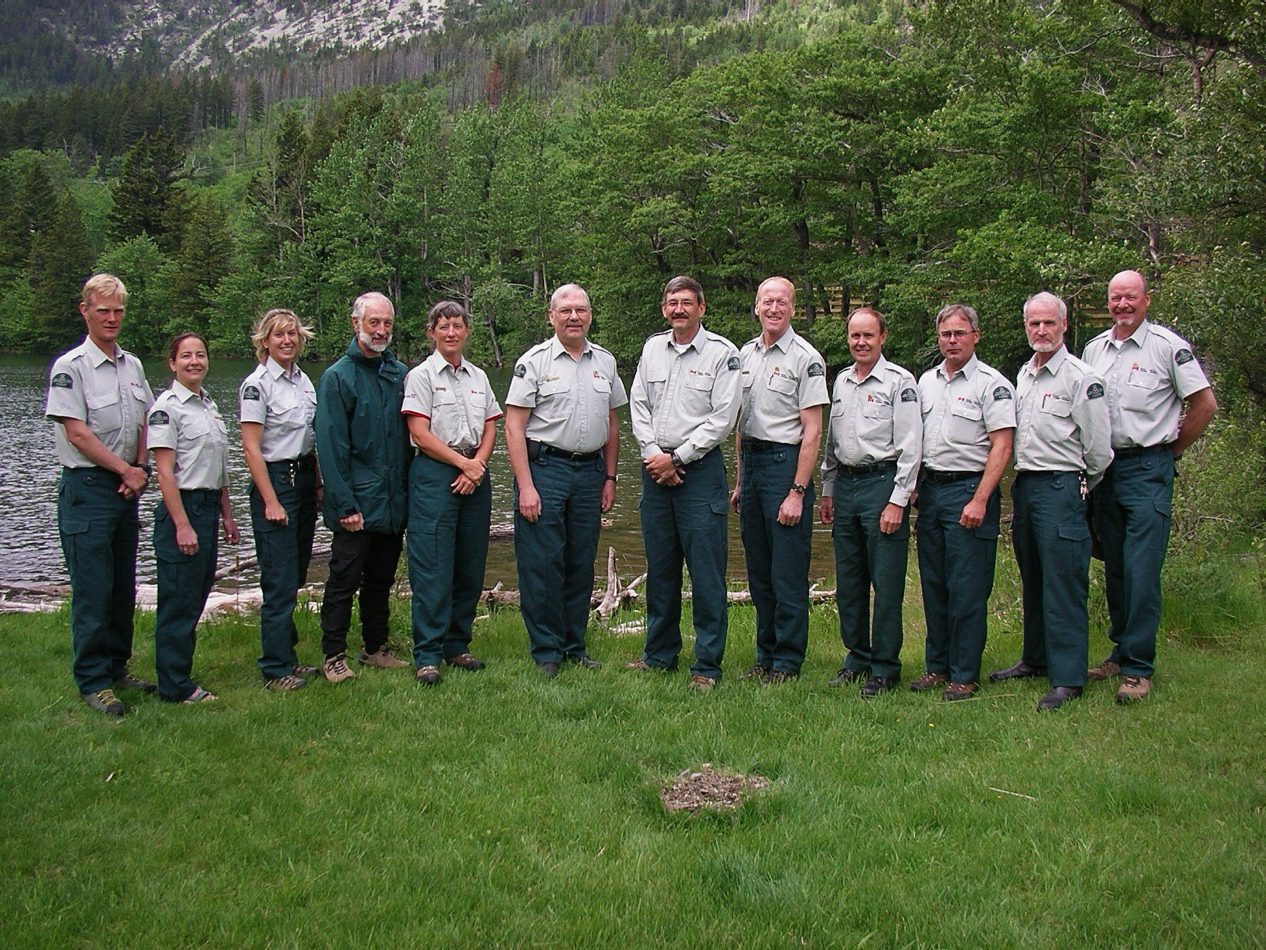
2007 Waterton Resource Conservation group photo: Jon Stuart-Smith, Barb Johnston, Mary Coleman, Peter Achuff,
Cyndi Smith, Bill Dolan, Randall Schwanke, Edwin Knox, Derek Tilson, Brent Kozachenko, Rob Watt and Bill Thorpe.
In 1999, I had the wonderful opportunity to work on assignment, in Ivvavik National Park in northwest Yukon on the Beaufort Sea. My wife and I lived in Inuvik for seven months. During that time, I made seven forays west into the park for work … it was a rare and wonderful experience seeing such remarkable wilderness … 10s of thousands of caribou, and muskox, wolf and grizzly bears. Fewer than 100 people a year visit that park – it is guided river rafting mostly. I saw nature …the wilderness – in all its glory! Indeed, a favourite park, what with the understanding of the richness it protected and the Inuvialuit people who lived nearby … they being of that land …and many of them – still on the land! After seven months I returned to Waterton, despite strong encouragement to apply on the Aulavik National Park Resource Conservation manager position – based in Sachs Harbour on Banks Island. Alice and I wanted to continue to make Waterton home. The isolation of the north would have been difficult.
What were some of your main responsibilities over the years?
I was a real generalist warden. Waterton was of a size that we all, pretty much, were active in the visitor safety function and the fire program. We all took our share of the duty officer shifts. Wildlife management … everyone helped. Most of 20 winters, I assisted on the avalanche forecasting team. I put in a winter too in Rogers Pass (2001) in Glacier National Park digging snow pits – contributing to the gathering of snowpack stability data for the forecasters there. In Waterton we’d take turns writing up the twice-weekly avalanche bulletins. I truly enjoyed that program. I feel I was a valuable contributor to the team that functioned collectively to get the whole suite of work done, that was the backbone of the park’s environmental protection and visitor safety responsibilities. And I saw the small tasks as well that helped the program. It might seem trivial but keeping snow and ice swept off the vehicle fleet – ready to go in the winter. And keeping the floor of the rescue bay swept clean and the gear room kept – as it should always be, in response-ready mode. Little things, but essential.
I managed the Invasive Plant Control Program in Waterton for a decade …while continuing to take duty officer shifts and help with all the other functions. I had a heart condition that was diagnosed in 2008. I was taking a firefighter fitness medical when a doctor heard something with his stethoscope. Turns out I had a couple of issues …acute AFib and a congenital bicuspid aortic valve. For about four years prior I knew something wasn’t quite right. Eventually I had to step down from visitor safety and duty officer responsibilities … a risk to myself and the team, what with the heart concern. I had debilitating heart fibrillation several times when at work – occurring even in the field. Over 50 episodes before I finally had a catheter ablation procedure in 2013. By then they understood I had a bad aneurysm in the ascending aorta and diagnosed the aortic valve deterioration …so that indeed necessitated me being pulled from “heavy” work. So, there I was …a real strong team member for mountain rescue and avalanche forecasting and had to step down. The doc who first diagnosed the AFib in 2008 called it “athletes’ heart”. All those years of carrying a pack with heavy skis/boots on my feet – ascending the steeps …thin air – maybe all took its toll. From when I was 18, I was running up the peaks – mad for cardiovascular exercise – summer and winter! And I was a runner through the 1980s, early ‘90s. Besides the heart concern, a knee issue flared, and I hung up the running shoes. But could I hike! I was on the initial response team for backcountry emergency/search response – always. And I skied like a trooper! Tilson called me “Death on the Trail.” There was an old-time U.S. Park Ranger – Reynolds, who was stationed at the head of Upper Waterton Lake in Glacier, Montana who had first earned that nickname for the miles he’d put on! The knee was OK mostly. I’m still managing with it! And in 2022 I got a new heart valve and aneurysm repair.
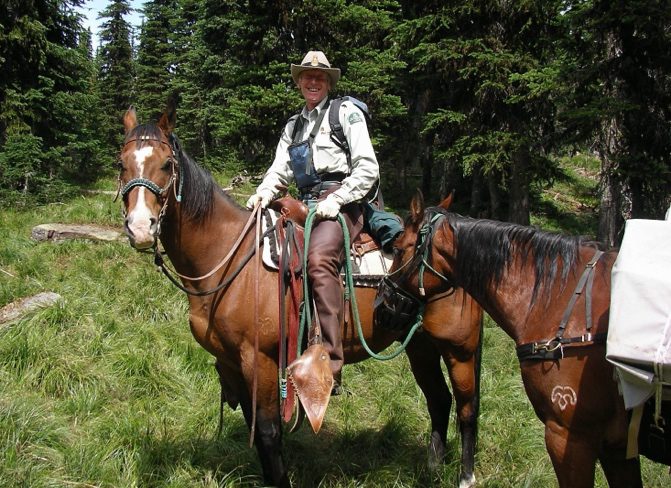
Edwin riding at Lone Lake riding Gordie and packing Floyd. Photo by Cyndi Smith 2007.
